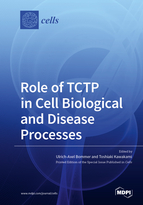Role of TCTP in Cell Biological and Disease Processes
A special issue of Cells (ISSN 2073-4409).
Deadline for manuscript submissions: closed (15 November 2019) | Viewed by 31665
Special Issue Editors
Interests: translational regulation of gene expression; cell stress response; cancer cell biology; cellular growth regulation
Special Issue Information
Dear Colleagues,
Translationally controlled tumour protein TCTP is a highly conserved, multifunctional protein present in almost all eukaryotic organisms. The protein is distinct from any other known protein families, but it interacts with a wide variety of client proteins. TCTP’s biological function can be broadly described as being cytoprotective; it is involved in promoting cell growth and developmental processes, and it protects cells under a range of biological stress conditions. Apart from acting at the cellular level, TCTP has been shown to be involved in extracellular functions that are typically part of anti-parasitic defence mechanisms or other aspects of host–parasite interactions.
Given the involvement of TCTP in several core cell biological processes, it is not surprising that an increasing number of diseases are being identified, where dysregulation of TCTP is shown to be involved. Apart from being overexpressed in a large number of human cancers, TCTP is also dysregulated in metabolic diseases, in processes of the immune system and in diseases affecting the circulatory system. These findings did already lead to first explorations of the possibility to exploit TCTP as a potential drug target, in particular in the area of cancer and allergy research.
Despite the large number of publications and review articles already published on this peculiar protein, we expect ‘TCTP’ to have still more interesting surprises in store for us. We presume that this ‘Special Issue’ of Cells will provide a suitable platform to both report and/or summarize the latest developments in the field.
We look forward to your upcoming contributions.
Prof. Ulrich-Axel Bommer
Prof. Toshiaki Kawakami
Guest Editors
Manuscript Submission Information
Manuscripts should be submitted online at www.mdpi.com by registering and logging in to this website. Once you are registered, click here to go to the submission form. Manuscripts can be submitted until the deadline. All submissions that pass pre-check are peer-reviewed. Accepted papers will be published continuously in the journal (as soon as accepted) and will be listed together on the special issue website. Research articles, review articles as well as short communications are invited. For planned papers, a title and short abstract (about 100 words) can be sent to the Editorial Office for announcement on this website.
Submitted manuscripts should not have been published previously, nor be under consideration for publication elsewhere (except conference proceedings papers). All manuscripts are thoroughly refereed through a single-blind peer-review process. A guide for authors and other relevant information for submission of manuscripts is available on the Instructions for Authors page. Cells is an international peer-reviewed open access semimonthly journal published by MDPI.
Please visit the Instructions for Authors page before submitting a manuscript. The Article Processing Charge (APC) for publication in this open access journal is 2700 CHF (Swiss Francs). Submitted papers should be well formatted and use good English. Authors may use MDPI's English editing service prior to publication or during author revisions.
Keywords
- translationally controlled tumour protein TCTP (alternative designations: fortilin or histamine releasing factor HRF)
- cell growth and developmental processes
- cell stress reactions
- apoptosis and autophagy
- cancer and other disease processes








